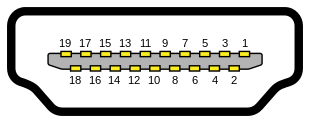引用:
A diagram of a type A HDMI receptacle, showing 10 pins on the top row and 9 pins on the bottom row (total 19 pins).
HDMI type A receptacle
Pin 1 TMDS Data2+
Pin 2 TMDS Data2 Shield
Pin 3 TMDS Data2−
Pin 4 TMDS Data1+
Pin 5 TMDS Data1 Shield
Pin 6 TMDS Data1−
Pin 7 TMDS Data0+
Pin 8 TMDS Data0 Shield
Pin 9 TMDS Data0−
Pin 10 TMDS Clock+
Pin 11 TMDS Clock Shield
Pin 12 TMDS Clock−
Pin 13 CEC
Pin 14 Reserved (HDMI 1.0–1.3a) Utility/HEAC+ (HDMI 1.4+, optional, HDMI Ethernet Channel and Audio Return Channel)
Pin 15 SCL (I2C serial clock for DDC)
Pin 16 SDA (I2C serial data for DDC)
Pin 17 Ground (for DDC, CEC, ARC, and HEC)
Pin 18 +5 V (min. 0.055 A)[3]
Pin 19 Hot Plug Detect (all versions) HEAC− (HDMI 1.4+, optional, HDMI Ethernet Channel and Audio Return Channel)





